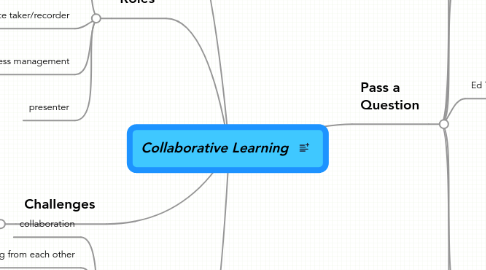
1. Challenges
1.1. Different skillsets
1.2. Match tool to the task
1.3. TIME
1.4. little info for the questions
1.5. consensus
1.6. staying on task
1.7. no chance to clarification
2. Roles
2.1. leader
2.1.1. agenda setter
2.1.2. social roles
2.1.2.1. no bullies
2.1.2.2. no wallflowers
2.1.2.3. everyone has chance to contribute
2.2. note taker/recorder
2.3. process management
2.3.1. timekeeper
2.3.2. errand monitor
2.4. presenter
3. Types
3.1. Simulation
3.2. Blended Learning
3.3. Small Group Learning
3.4. Social Networking
3.5. Projects
4. Rewards
4.1. collaboration
4.2. learning from each other
4.3. building communication skills
4.3.1. spoke in bullets
4.4. many minds
4.5. coming from every direction
4.6. staying to roles
4.7. listen carefully
4.8. focuses
4.9. not to dominate
4.10. trust
4.11. honor contributions of the many
5. Pass a Question
5.1. Engagement
5.1.1. provide rationale / value
5.1.2. case studies
5.1.3. hands on learning
5.1.3.1. see one, do one, teach one
5.1.4. asking questions of learners
5.1.5. food / rewards
5.2. Learning styles
5.2.1. visual, tactile, auditory, etc
5.2.2. diff techniques
5.2.3. return demo
5.2.4. samples
5.2.5. debriefing
5.3. Skill levels vary
5.3.1. one on one mentoring
5.3.2. consensus on objectives
5.3.3. collab content design
5.4. Ed Tech
5.4.1. take advantage of experts
5.4.2. colleagues
5.4.3. handy reference materials / cheatsheets
5.4.4. networking
5.4.5. sign up for classes
5.5. Planning
5.5.1. learning objectives
5.5.1.1. needs assessment
5.5.1.2. description of audience
5.5.2. methods
5.5.2.1. determine source of problem
5.5.2.2. adult learning styles
5.5.2.3. determine if knowledge deficit or motor
5.5.3. evaluation
5.5.3.1. metrics
5.5.3.1.1. survey
5.5.3.1.2. pre/post
5.5.3.1.3. attitudinal
5.6. Time/Resources shortage
5.6.1. more effective methods
5.6.2. set brief achievable goals
5.6.3. benchmarking
5.6.4. sharing lessons learning
5.6.5. sharing cost info to determine constraints
